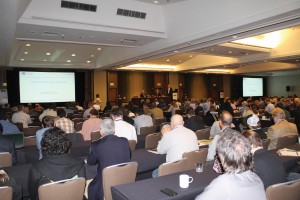New Tools for IPM

Biocontrols USA Conference 2016
Biocontrol was the highlight, but its crucial role in integrated pest management programs was the underlying focus of the recent Biocontrols USA 2016 Conference & Expo. The consistent message throughout the two-day event was the need to constantly adapt to use all of the tools in the crop protection toolbox, including biopesticides and other biocontrols.
“We’re really going to have to change the way we do things,” said Denise Manker, Director, Agronomic Development of Biologics, Bayer CropScience Biologics Division.
More than 450 growers, certified pest control advisers, researchers, and allied company representatives attended the event — presented by Meister Media Worldwide in conjunction with the Biopesticide Industry Alliance — in Monterey, CA, March 3-4.
Grounded, how-to sessions educated growers and crop advisers on a variety of topics. Presentations provided information on everything from details on new biopesticide product releases for 2016, to techniques to help growers implement a biocontrols trial in their own operations, to effectively combining biopesticides and beneficials. One session even covered up-and-coming techniques, including RNA interference and the highly publicized CRISPR, which may well be the next significant leaps in pest control technology.
Dozens of attendees also took advantage of a field tour of biocontrol use in Salinas Valley vegetable fields and in the production system at greenhouse ornamentals young plant grower, Pacific Plug & Liner in Watsonville, CA. Others took part in a three-hour workshop offering hands-on methods and advice to improve the use of biocontrol in their operations.
In addition to the day and a half of educational sessions, attendees had an opportunity to meet one-on-one with nearly 40 leading biocontrol product and service suppliers from around the country and around the world.

Mark Trimmer
New Biopesticides Highlighted
Mark Trimmer, Managing Partner, Dunham Trimmer LLC, offered a presentation on “New and Novel Biopesticide Products for 2016,” calling attention to several new materials from around the industry.
“This is an innovating, dynamic market, with a lot of new things that are coming — brand new products, new formulations, and established products that will be distributed by new companies.” he said.
Trimmer highlighted a number of upcoming biofungicides, including:
• A new formulation of Marrone Bio Innovations’ Regalia,
• A new microbial fungicide, now called BmJ (active ingredient Bacillus mycoides isolate J) from Certis USA, which is pending approval this year with plans to launch in 2017,
• A new microbial fungicide, BotryStop, licensed in U.S. by BioWorks, and
• FMC’s Ethos XB, a Bacillus amyloliquefaciens strain D747 combined with bifenthrin for control of rootworms, cutworms, and wireworms, and suppression of key seedling diseases.
Trimmer also mentioned a handful of bioinsecticides, including Vestaron’s Spear, which is based on spider, scorpion and sea anemone peptides; and Certis USA’s microbial insecticide, PFR-97, which targets aphids, citrus psyllid, spider mites, thrips, and whiteflies.
Bionematicides were a topic of discussion as well.
“Historically, nematicides have been one of the most toxic chemicals. Now we’re finally starting to see some very interesting biologicals coming to market,” he said.
Marrone Bio Innovations’ Majestene, for example, is a new microbial nematicide with multiple modes of action against nematode eggs and juveniles, and is active against a wide range of nematode species, Trimmer said.
Update from U.S. EPA
Conference attendees received a regulatory update from Robert McNally, Director of U.S. Environmental Protection Agency’s (EPA) Biopesticides and Pollution Prevention Division.
The Biopesticides and Pollution Prevention Division (BPPD), established in 1994, has registered more than 400 biological active ingredients. The goal of BPPD is to reduce the regulatory burden as an incentive to companies to bring biopesticides to the market.

Robert McNally
“We make about 15 new biopesticide active ingredient decisions per year,” McNally said. “So far in 2016, we have registered six new materials through March, with a few rejected.”
Under the Pesticide Registration Improvement Extension Act, the fee to register a new “conventional” active ingredient is about $600,000. To register a new biopesticide active ingredient, the fee is one-tenth as much — about $60,000.
“We think that will help foster development of more biopesticides,” he said.
Biostimulants continue to be a topic of discussion within EPA.
“There is an increasing market for biostimulants and lack of certainty regarding whether products need regulation. We have to be thoughtful about what approach to take. We want to have a lighter touch,” he said.
EPA is working to develop guidance on biostimulants, and McNally expects to have something done in 2016.
He hopes such discussions regarding biopesticides will also be useful elsewhere, as BPPD’s influence is not limited to materials solely for the U.S.
“Biopesticides are viewed positively internationally. We have offered help to our colleagues in Europe and will be meeting with them in April,” McNally said.
Richard Jones is Executive Editor of Meister Media’s U.S. Horticulture Group. Contact him at [email protected]





